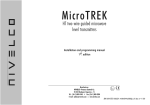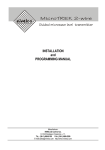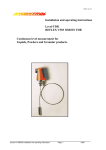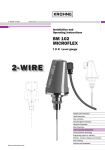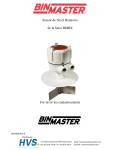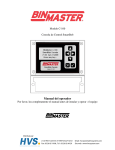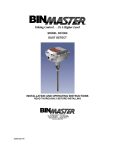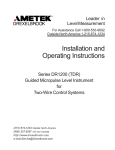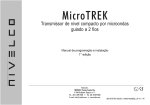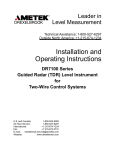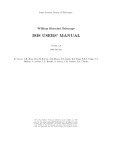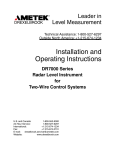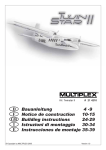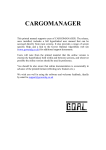Download - BinMaster
Transcript
GWR-1000 Two-Wire Guided Microwave Level Transmitters BinMaster: Division of Garner Industries 7201 N. 98th St., Lincoln, NE 68507 402-434-9102 • email: [email protected] www.binmaster.com OPERATING INSTRUCTIONS PLEASE READ CAREFULLY 925-0311 Rev B 0113 GWR-1000 Two-Wire Guided Microwave TABLE OF CONTENTS 1.0 INTRODUCTION...................................................................................................................... 3 2.0 ORDER CODE......................................................................................................................... 4 3.0 TECHNICAL DATA................................................................................................................... 5 3.1 Accessories....................................................................................................................... 8 3.2 Maintenance and repair..................................................................................................... 8 4.0 MECHANICAL INSTALLATION.............................................................................................. 8 4.1 Handling and storage........................................................................................................ 8 4.2 Mounting on the tank....................................................................................................... 10 4.2.1 Installation instructions: general notes......................................................................... 10 4.2.2 Specific installation instructions: gauge - solid applications........................................ 12 4.3 Wiring............................................................................................................................... 13 4.3.1 BUS (HART®) communication..................................................................................... 16 4.4 Power-on and start-up..................................................................................................... 16 4.5 Available user interfaces................................................................................................. 16 5.0 PROGRAMMING................................................................................................................... 16 5. Programming with SAP-300 display unit......................................................................... 17 5.1.1 SAP-300 display unit.................................................................................................... 17 5.1.2 GWR-1000’s behavior in manual programming mode................................................ 17 5.1.3 Manual programming................................................................................................... 18 5.2 Programming with HART® handheld (HHC) Communicator.......................................... 19 5.2.1 Characters available for alpha-numerical data functions in PCSTAR2 and on the HART® console.................................................................... 25 5.3 GWR-1000 2-wire T.D.R. meter characteristics.............................................................. 25 5.3.1 Gauge operating logic when the reflection is lost........................................................ 26 5.3.2 Gain and voltage amplitude......................................................................................... 27 5.3.3 Typical signal trends..................................................................................................... 29 5.3.4 Automatic adjustment................................................................................................... 30 5.3.5 Level measurement when more than one phase or layer in the tank......................... 31 5.4 Troubleshooting............................................................................................................... 32 5.5 Appendix 1 – Set-up parameters of GWR-1000 H-400 series in Multicont controller..... 35 925-0311 Rev B 0113 GUIDED MICROWAVE LEVEL MEASUREMENT 1.0 INTRODUCTION Application The GWR-1000 2-wire level gauge uses the Time Domain Reflectometry (TDR) measuring principle and two-wire technology for level measurement. It is designed for measuring the distance, level and volume of liquids, pastes, slurries and powder products. The device is applicable in tanks, silos, rigid pipes, reaction vessels and level reference vessels. The device is HART capable, it can be programmed using a HART Handheld Communicator (HHC), a Multicont universal process controller and PCSTAR2 software supplied as standard with the gauge. Operating principle The GWR-1000 2-wire guided microwave level transmitter uses the TDR (Time Domain Reflectometry) principle. The instrument sends low power nanosecundum wide pulses along an electrically conductive rod, cable or coaxial probe with a known propagation speed (the speed of light). As the pulse reaches the surface of the medium or phase of two liquids (altered dielectric constant Er), a part of it is reflected back to the electronic module. The efficiency of the reflected signal depends on the dielectric constant Er difference of the mediums or layers. (From the plain surface of airwater phase the reflected signal's strength will be approximately 80% of the emitted signal). The reflected pulse is detected as an electrical voltage signal and processed by the electronics. Level distance is directly proportional to the flight time of the pulse. The measured level data is converted into 4-20 mA current and HART signals and is displayed on the LCD display. From the level data further derived measuring values can be calculated such as volume and mass. The TDR technology is unaffected by the other properties of the medium as well as that of the space above it. 925-0311 Rev B 0113 GWR-1000 Two-Wire Guided Microwave INTRODUCTION GWR-1000 Two-Wire Guided Microwave 2. ORDER CODE 1. Transmitter & 1-1/2” Process Connection 2. Flexible Probe Assembly & Counterweight Example: Our standard Guided Wave Radar Transmitter with a 40’ single flexible Ø 8 mm 316 stainless steel cable/counterweight, 1-1/2” SS fitting, and SAP-300 local plug-in LCD display unit would be a 730-5150-CP6-40’-SAP300. MODEL MICROWAVE REMOTE TRANSMITTER DESCRIPTION PART NO. GWR-1000 2-Wire Guided Microwave Level Transmitter, 18-35 VDC, 4 to 20 mA output with HART, process temperature from –22°F to 195°F (-30°C to 90°C). Aluminum housing with powder coated finish, 1-1/2” stainless steel process connection, for use with the single flexible Ø 8 mm 316 stainless steel cable. General purpose IP65 (for local LCD display you must order SAP-300). 730-5150 GWR-1000 HT High temperature 2-Wire Guided Microwave Level Transmitter, 18-35 VDC, 4 to 20 mA output with HART, process temperature from –22°F to 392°F (-30°C to 200°C). Aluminum housing with powder coated finish, 1-1/2” stainless steel process connection, for use with the single flexible Ø 8 mm 316 stainless steel cable. General purpose IP65 (for local LCD display you must order SAP-300). 730-5151 GWR-1000 L 2-Wire Guided Microwave Level Transmitter, 18-35 VDC, 4 to 20 mA output with HART, process temperature from –22°F to 195°F (-30°C to 90°C). Aluminum housing with powder coated finish, 1” stainless steel process connection, for use with the single flexible Ø 4 mm 316 stainless steel cable. General purpose IP65 (for local LCD display you must order SAP-300). 730-5152 GWR-1000 LHT High temperature 2-Wire Guided Microwave Level Transmitter, 18-35 VDC, 4 to 20 mA output with HART, process temperature from –22°F to 392°F (-30°C to 200°C). Aluminum housing with powder coated finish, 1” stainless steel process connection for use with the single flexible Ø 4 mm 316 stainless steel cable. General purpose IP65 (for local LCD display you must order SAP-300). 730-5153 ORDER CODE MICROWAVE PROBE TYPE DESCRIPTION CP8-(length) Single flexible Ø 8 mm 316 stainless steel cable, with counter weight. Maximum length 78 ft. Used on microwave remote transmitters with 1-1/2” NPT fittings, for measurement of liquids and heavy-weight bulk solids. CP4-(length) Single flexible Ø 4 mm 316 stainless steel cable, with counter weight. Maximum length 78 ft. Used on microwave remoter transmitters with 1” NPT fittings, for measurement of liquids and light-weight bulk solids. ORDER CODE SAP-300 925-0311 Rev B LOCAL DISPLAY UNIT DESCRIPTION Local plug-in LCD display unit. With the help of the SAP-300 plug-in display, a simplified programming can be accomplished which covers most applications. The basic parameters of measurement and output can be set using the text-based menu system of the SAP-300. The large LCD dot-matrix display displays the measured values in numerical and bar graph form. 0113 GWR-1000 Two-Wire Guided Microwave 3. TECHNICAL DATA GENERAL DATA Input data Measured values Between the reference point of the unit and reflection plane (material surface), distance, level, and volume Measuring range Depends on probe type and the properties of the measured medium (see technical data: Probes table) Probe types and technical data Coaxial, twin cable, mono cable, twin rod and mono rod probes (see technical data Probes table) Housing Aluminium cast with epoxy coating Medium temperature Flange temperature: –30°C ... +90°C Medium pressure - 0.1 … 1.6 MPa (-1… 16 bar) maximum allowed pressure at 20°C for 1.4571 (stainless steel) flange 4 Mpa (40 bar) Ambient temperature –30°C …+60°C, with display: –20°C … +60°C Sealing FPM (Viton®), optional for high temp version Perfluoroelastomer (Kalrez® 6375), EPDM Ingress protection IP 65 (NEMA 4 – 4X) Power supply 18 … 35 V DC, nominal 24V DC Output signals Analogue: 4 … 20 mA, (3.9 … 20.5 mA) passive output, error 22 mA BUS: serial line, HART® interface, terminal resistor max. 750 ohm Display: SAP-300 LCD matrix Output data Accuracy Liquids: ±5mm. For probe length L ≥10m ±0.05% of the range Under ideal reflection and stabilized temperature conditions. Solids: ±20mm. For probe length L ≥ 10m ±0.2% of the range Resolution ±3µA Electrical connection 2 x M20x1.5 metal cable glands Cable diameter: 7 … 13 mm (Ex), or M20x1.5 plastic cable glands, Cable diameter: 6 … 12 mm wire cross-section: 0.5 … 1.5 mm2 (shielded cable is advised) + 2 x NPT ½” for cable gland Electrical protection Class III Mass (housing) 1.5 kg 925-0311 Rev B 0113 GWR-1000 Two-Wire Guided Microwave TECHNICAL DATA OF THE PROBES Application Continuous level measurement Materials Powders, granules, bulk solids, and liquids Dielectric Constant ≥ 2.1 Measured Values Distance, level, volume Measuring Range Up to 78’ Housing Aluminum with red epoxy paint Enclosure Type IP65 Weight 3.3 lb. (1.5 kg) without cable and probe Cable Type Flexible 0.32” (8 mm) or 0.15” (4 mm) 316 stainless steel mono cable Probe Type Stainless steel Pressure Up to 232 psi Temperature -22°F to 195°F (-30°C to 90°C) Standard model; Connection 1-1/2” NPT with .032” (8 mm) cable, 1” NPT with 0.15” (4 mm) cable Power Supply 18-35 VDC Output Signal 4-20 mA Communication Protocol HART 1" NPT 1.50" Dia. (38 mm) GWR-1000 8 mm cable used in liquids and heavier bulk solid materials 925-0311 Rev B 0.15" Dia. (4 mm) 1.0" Dia. (25.4 mm) 4 in. (102 mm) Up to 78 ft. (24 m) 0.32" Dia. (8 mm) 8 in. (203 mm) Up to 78 ft. (24 m) 1-1/2" NPT GWR-1000L 4 mm cable used in liquids and heavier bulk solid materials 0113 GWR-1000 Two-Wire Guided Microwave Nameplate 1 TYPE CODE AS ORDER CODE 2 Serial number Serial number 3 Supply 18.35V DC 4 Output 4-22mA, HART IP65 5 Ambient temperature -30°C … +60°C 6 Proc. temperature -30°C … +90°C pmax=16bar 402-434-9102 Lincoln, NE USA 1, 2 Supply: Output: Amb. temp.: Proc. temp.: MADE IN HUNGARY 925-0311 Rev B 3 4 5 6 0113 GWR-1000 Two-Wire Guided Microwave 3.1 ACCESSORIES • Installation and programming manual • 2 pcs M20x1.5 cable gland • SAP-300 display module (option) 3.2 MAINTENANCE AND REPAIR GWR-1000 does not require maintenance on a regular basis. In some very rare instances, however, the probe may need cleaning to remove deposited material. This must be carried out gently, without damaging the probe. Repairs during or after the warranty period are carried out exclusively at BinMaster. The equipment sent back for repairs should be cleaned or neutralized (disinfected) by the user. 4. MECHANICAL INSTALLATION 4.1 HANDLING AND STORAGE The device will weigh between approximately 3 kg or 7 lb and 12 kg or 25 lb. Carry using both hands to lift the device carefully by the converter housing. If necessary, use lifting gear. No attempt should be made to lift the instrument by its probe. Caution: The probe is a critical gauge component. Do not damage - Handle with care! 925-0311 Rev B 0113 GWR-1000 Two-Wire Guided Microwave Avoiding blows - avoid hard blows, jolts, impacts, etc. Caution: fragile electronics Avoid bending (single rod and coaxial probes) Support the probe to avoid bending. Avoid cable kinks and fraying. Do not coil the cable less than 400 mm or 16” in diameter. Cable kinks or fraying will cause measurement errors. Storage temperature 925-0311 Rev B 0113 GWR-1000 Two-Wire Guided Microwave 4.2 MOUNTING ON THE TANK 4.2.1 INSTALLATION INSTRUCTIONS: GENERAL NOTES Prior the installation some consideration is to be made regarding tank fittings and tank shape, nozzle position in relation to the tank walls and other objects inside the tanks. (Warning: This free area will depend on the probe type selected: refer to later on in this section) type of tank roof, i.e. floating, concrete, integral, etc; and base, i.e. conical, etc. Whenever working on an installation, remember to: Disconnect the power supply before starting work. However, the gauge may be installed when the tank contains product. Threaded process connections The simplest and most economic way is to mount the GWR-1000 2-wire directly on the tank with the 1” (1½”) BSP or 1” (1½”) NPT threaded connection. Nozzle height Do not fit a nozzle longer than its diameter, especially for single probes and powder applications h ≤ Ød, where h = nozzle height and d = nozzle diameter Contact BinMaster if this relationship cannot be respected. Nozzles penetrating into tank Do not use nozzles that penetrate X Caution: into the tank. This will disturb the emitted pulse. Installation of two devices If two devices are to be used on the same tank, these should be mounted at a distance of at least 2 m or 6.5 ft away from each other. If not, interferences from the electromagnetic (EM) fields generated by both instruments may cause measurement errors. Coaxial probes: The outer shell of the probe contains the EM field: No minimum distance required. 925-0311 Rev B 0113 Install far from entry pipe Caution: Do not put the nozzle close to the entry pipe. GWR-1000 Two-Wire Guided Microwave Process connection and entry pipe or use a deflector plate medium Pouring the product directly onto the probe will give false readings. Install a deflector plate if impossible to distance gauge from entry pipe. Stilling wells Tanks with floating roofs for petrochemical applications: Use a stilling well. 1 2 3 4 5 6 Stilling well Tank Floating roof Product (petroleum applications) Well fixed to tank base (no roof deformation) Sediment Probes: Entanglement, straightness and tank bottom clearance Cable probes must be straight once inserted into the tank. They must also be far from other objects (e.g. mixers) to avoid entanglement. In order to maintain the gauge’s operating characteristics, it is recommended to avoid touching the tank bottom with the counterweights (for cable probes) or probe end (other types). Avoid mounting near objects (discontinuities) inside the tank that influence the probe’s EM (electromagnetic) field. Install the gauge far from protruding objects such as: heating tubes, sudden changes in tank cross-section, tank wall reinforcements and beams, weld lines and dip-stick pipes, etc... 925-0311 Rev B 0113 GWR-1000 Two-Wire Guided Microwave Fastening the probe to the tank bottom Flexible probes can be fastened with a chuck (ring), turnbuckle or similar fastening device to the tank bottom. Shortening cable probes If required, the cable probe can be shortened, but this applies only when used in liquids. Procedure 1. Detach socket set screw M6x10 (ISO 4026)with 5 mm Allen (hexagon) key (ISO 2936). 2. Pull cable out of counterweight and shorten to required length using cable cutters to prevent the cable wires and strands from splaying out. 3. Insert cable back into counterweight and tighten down screws. 4. Change configuration parameters to new probe length; the reference point is the top edge of the weight (user menu function 1.1.6). 4.2.2 SPECIFIC INSTALLATION INSTRUCTIONS: GAUGE - SOLID APPLICATIONS FALSE READINGS: 1. Do not let the probe touch the side of the nozzle. 925-0311 Rev B 0113 GWR-1000 Two-Wire Guided Microwave Conical silo nozzles, false readings and traction on the cable probes 2. High traction forces: We recommend that the probe should not be anchored to avoid excessive traction loads on the cable. 3. Bending and traction: Position the connection on the roof at ½ radius of the tank and with minimum nozzle height. This will avoid damage due to bending and traction during emptying. Traction load is dependent upon the height and shape of the tank, product particle size & density, and the rate at which the tank is emptied. The table below gives the load up to which cable probes will hold. Probe type Material Probe Length 6 m Probe Length 12 m Probe Length 24 m Mono cable Ø8 mm, max. load: 3.0 T Cement 0.6 T 1.2 T 2.4 T Fly ash 0.3 T 0.6 T 1.2 T Product buildup can occur under the nozzle: This may weaken the pulse. Avoid cavities that permit the build up of deposits. Tank roofs should support loads of at least 3 T for gauge installations using Ø8 mm or 0.3” single cable probes. 4.3 WIRING 1. Detach the cover of the unit. 2. Guide the cable into the housing through the cable gland. 3. Remove a 4 mm length of isolation from the wires and cut away the free part of the shielding. 4. Connect the wires of the current loop to terminals 2 and 3 (any polarity). 5. Pull back the cable till a 10 mm cable length remains in the housing behind the cable gland. Tighten the cable gland using two spanners. Check the connection of wires and the tightness at the cable gland. 6. Array the wires in the housing and screw the cover on the housing. The 500V AC insulation test should not be performed on the instrument because of the overvoltage protection of the electronics. 925-0311 Rev B 0113 GWR-1000 Two-Wire Guided Microwave Connection to the EP network (grounding). Screw type terminal (EP) on the housing max. Cable cross-section: 4 mm². The housing of the GWR-1000 must be grounded. Grounding resistance R < 1 Ohm The shielding of the signal cable should be grounded at the control room. Avoid coupling of electromagnetic noises place the signal cable away from power current cables. Electrostatic discharge (E.S.D.) GWR-1000 2-wire electronics are shielded up to 4 kV against E.S.D. Note: E.S.D. cannot be solved by GWR-1000 2-wire E.S.D. protection. It is the customer’s responsibility to avoid E.S.D. by grounding the tank, product and probe installation. DANGER OF INJURY 1. The probe may receive an electrostatic discharge during operation; ground the probe by pushing it against tank wall with a suitably isolated tool just before touching it to avoid receiving a shock. 2. Ground the entry pipe and product. Non-hazardous-duty version Us = mA RA HART 4...20mA UE L Power supply Nominal voltage 24V DC Maximum voltage (Uinput): 35V DC Minimum voltage (Uinput): dependent on load impedance, see graph below Load impedance RA Loop resistance, Rloop RHART + Rcable + Rammeter Ohm Minimum load impedance RA 0 Ohm Maximum load impedance RA 750 Ohm 250 Ohm, recommended RHART resistance for HART® communication 925-0311 Rev B 0113 GWR-1000 Two-Wire Guided Microwave Line A = minimum voltage at the GWR-1000 2-wire terminals Line B = minimum supply voltage (for voltage drop caused by a 250 Ohm loop resistance) Example for calculating the power supply: The voltage drop is tested at 22 mA: U power minimum 22 = 22 mA x load impedance + U input minimum 22 U power minimum 22 = 22 mA x 250 Ohm + 10 V = 5.5 V + 10 V = 15.5 V In order to cover the whole current range, the voltage drop must also be tested at 4 mA: By analogy, the following applies: U power minimum 4 = 4 mA x load impedance + U input minimum 4 U power minimum 4 = 4 mA x 250 Ohm + 18 V = 1 V + 18 V = 19 V At a load impedance of 250 Ohm a power supply voltage of 19 V is sufficient to energize the current device range of 4 to 20 mA. 925-0311 Rev B 0113 GWR-1000 Two-Wire Guided Microwave 4.3.1 BUS ( HART®) COMMUNICATION GWR-1000 has two output options: Current out. and HART® Passive, HART® protocol Intrinsically safe passive, HART® protocol In accordance with the Rosemount Standard, HART® communication can be used with a GWR-1000 2-wire. It is used as a point-to-point connection between the GWR-1000 2-wire as slave and the HART® master. 4...20 mA + HART N x 4 mA + HART converter HARTHHC PCSTAR2 or HART spcific software and operating devices HARTHHC HART-Master 4.4 POWER-ON AND START-UP The GWR-1000 2-wire is pre-configured in accordance to customer order specifications and measurements can be made immediately. A start-up time of less than 60 seconds should be allowed once the unit is connected and the power is switched on. If the probe length has been shortened since delivery, please refer to section 3.3.1: Summary of User Functions, user function 1.1.6: Probe length to modify configured probe length. 4.5 AVAILABLE USER INTERFACES Programming of GWR-1000 can be done using the following instruments/accessories: PCSTAR 2 software Accessory shipped with the instrument. See chapter “5.1 Programming with PCSTAR 2 software” (PC needed.) SAP-300 display unit Can be ordered. See chapter “5.2. Programming with SAP-300 display unit”. HART® (HHC) Handheld Communicator Sold separately. Automatic device detection on powering. See chapter “5.3 Programming with HART® (HHC) Communicator”. 5. PROGRAMMING GWR-1000 can be programmed in three (basic) ways. • Programming with PCSTAR 2 software • Programming with SAP-300 display unit • Programming with HART® Handheld (HHC) Communicator (For operating instruction see the User manual of the HHC) 925-0311 Rev B 0113 GWR-1000 Two-Wire Guided Microwave Programming with SAP-300 display unit The main parameters of the GWR-1000 can be set using the SAP-300 display unit. The default display shows the primary measured value (which the output current is calculated from). Besides the numerical display there is a bargraph on the right showing the value of the current output. Programming is helped by a text-based menu. Navigation in the menu can be done with buttons. 5.1.1 SAP-300 DISPLAY UNIT Display Ambient temperature Housing material 64x128 Dot-matrix LCD, glyphs, units and bargraph – 20°C…+60°C PBT fiberglass, plastic (DuPont®) SAP-300 is a plug-in LCD display and programming module. Warning! The display of the SAP-300 is based on LCD technology; do not expose the SAP-300 to continuous direct sunlight to avoid display damage. If GWR-1000 is not equipped with a sunshade and ambient temperature exceeds the operating temperature of SAP-300 do not leave the SAP-300 in the instrument! 5.1.2 GWR-1000’S BEHAVIOR IN MANUAL PROGRAMMING MODE After power-up GWR-1000 shows the measured value on the SAP display. REMOTE MODE: If the instrument senses external HART communication, it changes its display mode and shows a "REMOTE MODE" message in the bottom of the display. In this mode, the measured values are refreshed according to the queries of the external HART master. If the HART master does not refresh, the display will show the last measured values. In the absence of SAP-300 the COM LED indicates the HART communication. If HART communication stops, the COM LED turns off after 120 sec. Entering the menu can be done by pressing the button. Scrolling the menu can be done by pressing and buttons. Enter into selected menu point with button. Exit to the previous menu with button. The buttons work only in presence of SAP-300 module. When leaving the GWR-1000 in (programming) menu, after 30 minutes the instrument automatically returns to measuring mode. If SAP-300 is removed, the instrument instantly returns to measuring mode. Because manual programming (with SAP-300) and remote programming (with external HART master, Multicont or PCSTAR2 software) cannot be performed at the same time (as both of them act like a HART master), only one programming mode has priority and this is manual programming. During manual programming the instrument sends the "BUSY" response to the external HART master device. (HART response code 32 - Device is busy). 925-0311 Rev B 0113 GWR-1000 Two-Wire Guided Microwave 5.1.3 MANUAL PROGRAMMING Main menu BASIC SETUP Sub-menu PCSTAR 2 param. ID TANK HEIGHT DEAD ZONE CLOSE-END BLOCKING DAMPING TIME PROBE LENGTH 1.1.1 1.1.2 1.5.1 1.1.3 1.1.6 CURRENT MODE FAILURE CURRENT CURRENT MIN CURRENT MAX ERROR DELAY 1.3.1 1.3.2 1.3.3 1.3.4 1.3.5 OUTPUT SETUP APPLICATION APPLICATION TYPE Changing parameters can be done by selecting a sub-menu and pressing in two ways: button Text-based list: Navigation is the same as in menu lists. Accept changes with button, cancel changes (and exit) with Numerical field: Serves for editing a numeric value. Editing is helped by a cursor (inverted character). Change the value of the selected digit with / buttons (there is no under-, and overflow between the characters). Selecting a digit can be done using the button. Accept changes with button. After accepting the parameter change the GWR-1000 checks the parameter and downloads it. If parameter is incorrect, the CHECK/WRITE FAILED! message appears. 925-0311 Rev B button. 0113 GWR-1000 Two-Wire Guided Microwave 5.2 PROGRAMMING WITH HART® HANDHELD (HHC) COMMUNICATOR Display and configuration can also be carried out with a HART® communicator... Communicator layout 1. 2. 3. 4. Two-pin jack for loop connectors LCD Function keys (F1 … F4) Action keys On/off UP Arrow DOWN Arrow LEFT Arrow Other functions: LEFT Arrow: RIGHT Arrow: n/a RIGHT Arrow Previous menu key Select key Wiring, standard (non-Ex) Displaying readings Use the UP and DOWN arrows to move to the correct line and then select with the RIGHT Arrow. 1 HART Communicator 1 Offline 2 → Online 3 Frequency Device 4 Utility F1 F2 F3 2 F4 Main menu Online 1 → 2 3 4 5 F1 <Process Var.> <Config./Test> <Access/Rights> <Watch status> <HART Variables> SAVE F2 F3 F4 Online menu 3 4 <Process Var.> 1 → <Measurements> 2 <Input/Outputs> SAVE F1 F2 HOME F3 F4 Measurement & input & output functions menu 925-0311 Rev B <Measurements> ♥ 1 → Lvl 878.00 mm 2 Dist 121.00 mm HELP SAVE F1 F2 HOME F3 F4 Measurement display function 0113 GWR-1000 Two-Wire Guided Microwave Configuration: Summary of user functions via HART® Communicator HC 275 (Version 1.00) Reset default values are in bold type in the “Input Range” column. Refer to the HART® HC275 Communicator operating instructions for further operating details. Function (Fct.) 1.0 PROCESS VAR. 1.1.0 MEASUREMENTS 1.1.1 LEVEL 1.1.2 DISTANCE 1.1.3 VOLUME 1.1.4 HEADSPACE VOLUME 1.2.0 1.2.1 INPUTS/OUTPUTS FUNCTION I Input Range Description Level value Distance value Volume value if a strapping table is programmed Headspace Volume value if a strapping table is programmed Function associated to the current output (Primary Variable). Current output value (mA) Percentage of PV range 1.2.2 1 1.2.3 % Function (Fct.) 2.0 CONFIG./TEST 2.1.0 OPERATION 2.1.1.0 BASIS PARAMETER 2.1.1.1 TANK HEIGHT 2.1.1.2 PROBE LENGTH 2.1.1.3 TIME CONSTANT 2.1.1.4 DEAD ZONE Warning: Critical Parameter 2.1.1.5 SENSOR INFO 2.1.1.5.1 Sensor upper limit 2.1.1.5.2 Sensor lower limit 2.1.1.5.3 Sensor min. span 2.1.2.0 DISPLAY 925-0311 Rev B Input Range Description Enter probe length to Tank height. 60000 mm or 2362” The tank height is defined as the distance between the bottom of the As per order tank and the lower flange surface. Enter 0 mm to tank This value has to be equal to the exact height but < 24000 length of the probe. The only situation mm or 1063” for changing this value is if the probe length has been changed. As per order Enter to 100 seconds The time constant allows filtering of possible signal fluctuations when the product 5 sec. surface is turbulent. Enter a value Measurements near the flange may not FCT. 1.5.1 (Detection be precise or reliable. Measurement delay) … probe length may not be precise in an area less than this recommended value, depending on See “Minimal measuring distance” the probe type. Technical data of the probes = Probe length =0 = 1 mm Read only Menu. Upper sensor limit. Read only Menu. Lower sensor limit. Read only Menu. Sensor minimum span. 0113 Input Range Description Select m, cm, mm, inch, Ft, optional unit mm 0, 1, 2, 3, 4, 5, exponential format, auto 2 Length unit of displayed value (level / distance). The optional unit allows the user to define a new unit (name and factor) see menu 2.1.2.1.3 2.1.2.1.3.0 DEFINE NEW UNIT 2.1.2.1.3.1 UNIT NAME 4 ASCII characters “UNIT” Optional unit name. User has to enter the unit name before using it in the menu “LENGTH UNIT”. 2.1.2.1.3.2 UNIT FACTOR Enter 0.0 to 100000 Optional unit factor. User has to enter the Unit Factor before using it in the menu “LENGTH UNIT”. With a factor 1.0, the unit is equivalent to one millimeter. With a factor 1000.0, the unit is equivalent to one meter. 2.1.2.1.2 DISPLAY FORMAT 1.0 2.1.2.2.0 2.1.2.2.1 VOLUME VOLUME UNIT 2.1.2.2.2 DISPLAY FORMAT Select m3, l, US Gal, Ft3, bbl, M3/h, Ft3/h, kg, Metric Tons, US Tons m³ 0, 1, 2, 3, 4, 5, exponential format, auto 2 Number of decimal places. Defines the displayed length values format (option of the HART® communicator H275). Unit for conversion values ("volume table"). The selected unit is only used to display the conversion value from the strapping table. Number of decimal places. Defines the displayed volume value format. (Option of the HART® communicator H275). Function (Fct.) 2.1.3.0 ANALOG OUTPUT 2.1.3.1 FUNCTION I Input Range Description Select Level, Distance, Volume, Headspace Volume Level Current output function (measured value to be displayed). Volume functions will appear if a volume table exists in menu 2.1.7.0 2.1.3.2 RANGE I Select 4-20 mA or 4-20 mA + 22 mA if error 2.1.3.3 ERROR DELAY 2.1.3.4 SCALE I min. 4 mA 2.1.3.5 SCALE I max. 20 mA 925-0311 Rev B Current output range 4 … 20 mA (1st choice). When the GWR-1000 2-wire is in error mode, the current output is frozen except 4 - 20 mA if the second choice is selected and then the current output is fixed at 22 mA. Select No delay, 10 s, 20 s, 30 s, This menu is available in case the range I 1 min, 2 min, 5 min, 15 min menu is set to 4-20 mA with error 22 mA. This parameter sets the delay before the No delay current output goes to 22 mA after the error mode occurred. Enter 0 to Scale I max Input the lower range value (corresponding to 4 mA) depending of the parameter 2.1.3.1 As per order chosen. Enter Scale I min to tank Input the upper range value (correspondheight ing to 20 mA) depending of the parameter 2.1.3.1 chosen. As per order 0113 GWR-1000 Two-Wire Guided Microwave Function (Fct.) 2.1.2.1 LENGTH 2.1.2.1.1 LENGTH UNIT 2.1.4.3 FRENCH COMMISSION NUMBER 2.1.4.4 GERMAN COMMISSION NUMBER 2.1.4.5 RELEASE NUMBER 2.1.4.5 PROBE TYPE 2.1.4.5 CHECKSUM 925-0311 Rev B Input Range 00000 01 Rod, Twin Rod, Cable, Cable +counterweight, Cable without counterweight, Twin Cable, Twin Cable + counterweight, Coax, Special 1, Special 2, Special 3 As per order GWR-1000 Two-Wire Guided Microwave Function (Fct.) 2.1.4.0 USER DATA 2.1.4.1 TAG 2.1.4.2 SERIAL NUMBER Description Tag number of device Read only menu. Each device has its own serial number Read only menu. This number is factory set. Refer to this number in case of warranty or service claims. Read only menu. This number is factory set. Refer to this number in case of warranty or service claims. Read only menu. Release number of the device (Software and Hardware version). Read only menu. Probe type attached to the flange. Read only menu. Similar to the release number. This parameter allows to identify the software version of device. 0113 2.1.5.1.2 2.1.5.1. LEV. PULSE GAIN THRESHOLD 2.1.5.2 DISTANCE INPUT 2.1.5.3 DETECTION DELAY 2.1.5.4 SEARCH PROBE END 2.1.5.5 RESET GWR-1000 2-wire SERIAL I/O ADDRESS 2.1.6.0 2.1.6.1 Input Range 2.1.7.2 INPUT TABLE Dynamic value. Amplitude of level pulse in millivolts. Read only value. Dynamic value. Amplification of level pulse (gain 0, 1, 2, or 3). Enter a value from Threshold of the level pulse (in millivolts). 50mV to 25000mV The threshold evolves in terms of gain amplification factor changing by the electronic 500 mV G3 converter. at 1000 mm Enter a value from This function forces the GWR-1000 2-wire to Fct. 2.1.1.4: Dead search for the product surface in a zone other zone to fct. 2.1.1.2: than the actual measuring zone. If there is no Probe length level signal, you can enter an estimated value. Enter a value This function forces the instrument not to 0mm or 0in to Fct. analyze reflections in a zone directly below the 2.1.1.4: Dead zone flange. The entered value of the detection delay must be smaller than the "dead zone" value. As per order Measured in the Automatically measures the probe length. units configured in The tank must be empty and the tank height fct. 2.1.2.1.1 must be configured to a value greater than estimated probe length for this to be done correctly. Restarts the GWR-1000 2-wire. Enter 0 to 15 Select m3, l, US Gal, Ft3, bbl, M3/h, Ft3/h, kg, Metric Tons, US Tons Liter [l] 0 to 20 points 0 (i.e. no volume table) 2.1.7.3 925-0311 Rev B DELETE TABLE Description Read only value. 0 2.1.7.0 STRAP TABLE 2.1.7.1 VOLUME UNIT GWR-1000 Two-Wire Guided Microwave Function (Fct.) 2.1.5.0 APPLICATION 2.1.5.1.0 THRESHOLD 2.1.5.1.1 LEV. PULSE AMP. Sets the address of the device when this latter is connected on a HART Multidrop networks. The current output drifts to 4 mA. 0 = 4 … 20 mA output current active 1 – 15 = in multidrop mode Unit for conversion values ("volume table"). The selected unit is used to define the strapping table values. This function defines the strapping table. The maximum number of points is 20. Each subsequent value must be greater than the previous one. The length and volume units can be changed later without affecting the settings in the table. Calculations are done automatically in the instrument. This function deletes the strapping table. 0113 Input Range Description Select 4 mA, 12mA, 20 mA, Other This function allows the current output to be tested. The output can be set to one of the listed values. With a reference ammeter, the calibration of the current output can be verified. Restricted access factory configuration menu. These parameters may be accessed via Fct. 3.2 “Specialist PSW (password). Yes or No. Enter 9-character code if “Yes”. No Disables the access lock on the configuration menu. The password must contain exactly 9 characters. E, R or U are used only. The password is displayed in a scrambled format. It allows BinMaster to decode the password in case it was forgotten. See BinMaster Service center or GWR-1000 2-wire Service Manual for code. This function displays the status of the device. 2.3.0 SERVICE 3.0 3.1 ACCESS RIGHTS MAINTENANCE PSW 3.2 SPECIALIST PSW 4.0 WATCH STATUS Function (Fct.) 5.0 HART® VARIABLES 5.1 MANUFACTURER Input Range GWR-1000 Two-Wire Guided Microwave Function (Fct.) 2.2.0 TESTS 2.2.1 TEST OUTPUT Description Read only menu BINMASTER 5.2 MODEL Read only menu 5.3 FLD DEV REV 1.0 Field device revision Read only menu 1.0 Software revision Read only menu 1.0 Hardware revision Read only menu 5.4 5.5 SOFTWARE REV HARDWARE REV 5.6 DEVICE ID 5.7 5.8 5.9 5.10 MESSAGE DESCRIPTOR DATE NUM RESP PREAM 5.11 5.12 TAG POLL ADDRESS 925-0311 Rev B Read only menu. The device ID is also the serial number of the device. 32 bytes of ASCII characters 16 bytes of ASCII characters Month Day Year (xx / xx / xx). Number of preamble in the response frame of the device Tag name of the GWR-1000 2-wire Address of the device 0113 GWR-1000 Two-Wire Guided Microwave 5.2.1 CHARACTERS AVAILABLE FOR ALPHA-NUMERICAL DATA FUNCTIONS IN PCSTAR2 AND ON THE HART® CONSOLE PCSTAR2 Fct. 12.6.1: Unit name, Fct. 1.4.4: Device number, Fct. 1.4.8: Option Fct. 5.7 Message, Fct. 5.8 Descriptor, Fct. 5.11 Tag HART® console (HHC) @ A B C D E F G H I J K L M N O P Q R S T U V W X Y Z [ \ ] ^ _ Space ! “ # $ % & ‘ ( ) * + ‘ . / 0 1 2 3 4 5 6 7 8 9 : ; < = > ? 5.3 GWR-1000 2-WIRE T.D.R. METER CHARACTERISTICS This subsection explains: The four principle configurations for setting up a measurement scale and what the user should be aware of in each case; What happens when the tank is full or empty; What is the level threshold and how to modify it and What happens when level is measured when more than one product in the tank; The measurement scale: Five possible configurations for analog current output – with “Level” selected in PCSTAR 2 function 1.3.1 : Current 1 Item A Tank height (Fct. 1.1.1) B Probe length (Fct. 1.1.6) C Detection delay (Fct. 1.5.1) D Non-measurable zone E Minimum distance between non-measurable zone and dead zone (Fct.: 1.1.2 – Fct.: 1.5.1) F Upper dead zone (Fct. 1.1.2) G Measuring range H Reference point at tank bottom (Fct.: 1.3.1 = Level) 925-0311 Rev B 0113 GWR-1000 Two-Wire Guided Microwave The configurations described below are illustrated in the above diagram (1) The “current output” range is smaller than the max. possible measuring range (2) The “current output” range is equal to the measuring range: Scale min.: 4 mA (Fct. 1.3.3) = tank height – probe length + H Scale max.: 20 mA (Fct. 1.3.4) = tank height – dead zone (3) The “current output” range is greater than the measuring range: Scale min.: 4 mA (Fct. 1.3.3) = 0.0 Scale max.: 20 mA (Fct. 1.3.4) = tank height – dead zone (4) The “current output” range is greater than the measuring range: Scale min.: 4 mA (Fct. 1.3.3) = tank height – probe length + H Scale max.: 20 mA (Fct. 1.3.4) = tank height (5) The “current output” range is greater than the measuring range: Scale min.: 4 mA (Fct. 1.3.3) = 0.0 Scale max.: 20 mA (Fct. 1.3.4) = tank height NOTE: The reference point for distance measurements is the bottom of the flange face. 5.3.1 GAUGE OPERATING LOGIC WHEN THE REFLECTION IS LOST The product reflection pulse is usually lost when the level is in the top dead zone or near the bottom of the tank. The diagram below shows the action taken by the gauge depending on where the last reflection was lost. Use PCSTAR 2 - F8-Marker display function to follow the measurement status of the gauge. Zone 1 : Dead and detection delay zones Marker “Tank full” and “Level lost” is displayed when the product enters the dead zone and no reflection is found. This will also occur once the level reflection is within the detection delay zone. The gauge assumes the tank is full and displays the maximum level value. The gauge searches for a reflection along the entire length of the probe. Zone 2: Full zone (and dead zone) Marker “Tank full” is displayed in this zone. If the gauge loses the signal in this zone, it reacts as in zone 1: the tank is assumed to be full. The gauge searches for a reflection along the length of the probe. Zone 3: Central measurement zone The gauge searches along the length of the probe for the largest pulse reflection. If the pulse is lost, the reading freezes at the last value. Marker “Level lost” will be displayed. Zone 4: Empty zone If the reflection is lost here, then the gauge assumes the tank is empty and marker “tank empty” is displayed. The gauge searches for a reflection in this zone, but makes a search along the entire length of the probe once every minute. The reading will remain frozen during this time. The short circuit reflection will become larger than product reflection at this time. 925-0311 Rev B 0113 GWR-1000 Two-Wire Guided Microwave 5.3.2 GAIN AND VOLTAGE AMPLITUDE As explained in the measuring principle in the introduction, the level of a product is converted from a return signal (the product reflection) received by the gauge: This signal has taken a certain amount of time to return to the gauge and it has a certain strength / size measured in millivolts (dependent on the dielectric constant Er of the product). All pulse signals returning to the gauge electronics block (including flange, obstruction and the product surface reflections) are converted to voltage amplitudes. The gauge’s microprocessor looks for part of the largest signal that is over a set voltage amplitude, called the “threshold”, and identifies this as the product being measured. For this signal to be usable by the gauge, the microprocessor will amplify the signal by increasing the gain. Once the signal is within a set “working” range, the gauge follows this signal. The gauge registers any changes in time for this part of the signal to return to the converter and translate this into a displayed level or volume. Gain is a function of voltage amplitude. This defines the default threshold value when the gauge is searching for the product level. A strong return signal will be given a low gain (i.e. Gain 0 or a small amplification). However, if the signal is very weak, then a Gain of 3 (i.e. high signal amplification) is given. Example of signal amplification: Level measurement: Level pulse amplitude and threshold After connection to a power supply, the GWR-1000 2-wire will: 1. Measure reflection pulses in terms of voltage amplitude by cycling through a set of gains. 2. Identify the highest amplitude as being the product level. 925-0311 Rev B 0113 GWR-1000 Two-Wire Guided Microwave The level signal can be optimized by way of two factors: Amplification factor The amplitude of the signals is proportional to the dielectric constant Er of the product. At low amplitudes the signal should be amplified. The amplification factor is dependent on the dielectric constant Er and on the probe type. The device sets the gain automatically. The following factors apply to the set gain. Gain Amplification factor 0 1.05 1 2.10 2 4.37 3 8.93 Level threshold The level threshold suppresses interference signals so that only the reflections from the product surface (level signal) are shown. The factory setting of the level threshold is suitable for standard applications. The threshold will need to be adjusted in the case of very low dielectric constants Er, multiple interference reflections or unfavorable installation conditions. The illustrations below show interference signals when the oscilloscope function is used. These reflections can be due to various causes, e.g. tank internals or multiple reflections within the measuring range. Even though the interference signals are very weak, the threshold should nevertheless be set to a value above these signals. 1 2 3 4 Initial pulse Flange reflection Level signal Interference signal 1 2 3 4 5 Initial pulse Flange reflection Level signal Interference signal Threshold In the diagram above it can be seen that the level of the threshold is not constant: 400 mV at 1000 mm or 3.3 ft, and only 250 mV at 10000 mm or 33 ft. No attenuation is required at a probe length ≤ 3000 mm or 10 ft. The form of the threshold is dependent on attenuation and is automatically adjusted by the device over the measured length. 925-0311 Rev B 0113 GWR-1000 Two-Wire Guided Microwave Setting the level threshold If the level threshold is set too high, i.e. it is greater than the amplitude of the level reflection, the device will not find any level even with maximum amplification. If the level threshold is set too low, i.e. it is below the amplitude of some of the interference signals, the device will identify and indicate one of these interference signals as a level reflection only if the tank is empty. Precise setting of the level threshold is especially important when the dielectric constant Er is low. To set, the level (amplitude of the reflection) must be known. A level of 500 mm or 20” is ideal. The level threshold should be halfway between the invalid interference signals and the level reflection signal. The reflection from the probe tip, which is clearly identifiable at a low Er value, does not need to lie below the level threshold. Take a look at all the reflections over the entire probe length and then change the level threshold and/or the amplification factor in the “Dynamic configuration (F11)” menu. 5.3.3 TYPICAL SIGNAL TRENDS The following diagrams show characteristic signals that have been recorded with the oscilloscope function. Rod or cable probe with gain 1 Rod or cable probe with gain 2 Coaxial probe with gain 1 Coaxial probe with gain 2 The signal from coaxial probes does not include the flange reflection, due to the mechanical setup which does not produce any change in impedance at the flange. The amplitude of reflection from the product surface increases as the level rises and decreases as the level falls. 925-0311 Rev B 0113 GWR-1000 Two-Wire Guided Microwave 5.3.4 AUTOMATIC ADJUSTMENT To maintain a sufficiently strong reflection signal, the gain is adjusted automatically. When the amplitude of the level reflection decreases, the gain will increase to compensate for the loss in signal amplitude. Gain and level threshold thus maintain the same proportion. At gain 3, the level signal 1: is located between a distance of 2000 and 4000 mm or 6.5 and 13 feet. 2: is the level threshold. This is shown on the left: The amplification factor is 3. The level has dropped, increasing the distance between level and flange. 1: is located over 4000 mm or 13 feet. 2: threshold 3: interference signals The interference signals are now below the level threshold (2), whose lower limit is 50 mV. In the diagram to the left, the amplification factor is 3. In both cases, the automatically adjusted gain of the threshold indicates all signals located above one-half of the amplitude of the level signal. In the event of operational or installation faults, you can frequently identify the cause of the fault by means of this function and normally eliminate it yourself. Should the fault persist, please send a copy of the screen (screen shots with F10) to BinMaster Technical Service at [email protected] Note that the threshold drops every 2000 mm or 6.5 feet. Solid application notes Most dry solid applications except powder or flakes with high dielectric constants Er, such as coal powder, are measured with a Gain of 3. If it is difficult to measure level at a certain point with the gauge using a Gain from 0 to 2, then an internal tank structure (exposed girder, etc.) is most likely to be within the electromagnetic pulse field area: the gauge will detect the largest signal and assume this is the product level. 925-0311 Rev B 0113 GWR-1000 Two-Wire Guided Microwave 5.3.5 LEVEL MEASUREMENT WHEN MORE THAN ONE PHASE OR LAYER IN THE TANK Level can be measured with more than one phase in the tank. This requires setting a parameter in the factory menu (Fct. 1.1.3: Application Type) to the following measurement mode: 2 liquids, 1 level 1 liquid, 1 level for measuring level with two or more phases for measuring one phase or liquid Characteristics The level of the top product can be detected if it has a minimum layer of approximately 100 mm - when measuring a top product with a dielectric constant of Er =2.4. The mode “2 liquids, 1 level” permits level to be measured even when more than 2 liquids are present in the tank. The first return signal is identified as being level and the second is ignored. This mode may be used with all probe types Example application 1: Level measurement of oil (1 liquid in the tank) signal / V Gas Liquid With Factory Menu Fct. 1.1.3: Application Type set to 1 liquid, 1 level, the GWR-1000 2-wire will search for the return signal with the highest amplitude (i.e. higher than the threshold). It will measure the oil level. 1. Level measurement signal 2. Threshold Example application 2: Level measurement when there are 2 liquids (oil/water) in the tank – using a correctly configured gauge With Factory Menu Fct. 1.1.3: Application Type set to 2 liquids, 1 level, the GWR-1000 2-wire will search for the first return signal higher than the control threshold. It will correctly measure the oil level (i.e. “level”). 1. Threshold 2. Level signal 3. Oil-water interface signal For further information, please contact BinMaster Technical Service at [email protected] 925-0311 Rev B 0113 GWR-1000 Two-Wire Guided Microwave 5.4 TROUBLESHOOTING Event Fault Action No fault. The level has reached (and possibly risen above) the top configured measurement limit and is either displaying the maximum (when measuring level) or minimum (when measuring distance) output. No fault. The level has entered the gauge’s bottom dead zone and can no longer detect a return signal. Either the maximum (when measuring distance) or minimum (when measuring level) output is displayed. No fault. The level has entered the gauge’s top dead zone and can no longer detect a return signal. None. Measurements should be normal once the level is in the configured measurement range. Error messages “Tank full” status marker on*, reading frozen at max. or min. value “Tank empty” status marker on*, reading frozen at max. or min. value “Tank full” and “Level lost” status marker on*, reading frozen at max. or min. value “Level lost” status marker on*, reading is frozen None. Measurements should be normal once the level is in the configured measurement range. Empty the tank below the top measurement range limit and check the measurement. The instrument has lost the level signal, has searched but not yet found the return pulse. This may occur if the pulse has dropped below the threshold. Parasite signals from the flange or obstructions in the tank may render the gauge unable to identify the correct signal. Ensure that tank is emptied below maximum level and check the measurement. If the signal is not detected, then modify the control threshold manually as shown in sections 5.4.2 using the oscilloscope (F7) and dynamic configuration (F11) windows in PCSTAR 2. “Reference not found” Occurs when there is a problem with the Please contact BinMaster. status marker on* time base on the HF board. “Level lost” and The probe has received an electrostatic The gauge will search for the level “Reference not found” discharge. again and resume readings. If the status markers on*, reading remains frozen then the reading frozen signal converter may have been damaged by ESD and may need replacing. Please contact BinMaster. “Flange not found” The signal converter has been incorrect- Contact BinMaster for the status marker on* ly configured to measure with a cable corrective procedure. or rod probe when it is equipped with a coaxial probe. This may also be due to installation on a long nozzle which has the effect of attenuating the flange pulse. “Delay out of limits” sta- The emitted pulse has not been detect- The signal converter may need tus marker on*, reading ed. The gauge will not work until it has replacing. is frozen. been found. Please contact BinMaster. “Negative voltage error”* Occurs when there is a problem with the Please contact BinMaster. time base on the HF board. “VC01 voltage error” * “VC02 voltage error” * “Reprogramming FPGA”* *Gauge connected to PCSTAR2 software or HART Handheld Controller (HHC) with Marker status window (F8) or list displayed. 925-0311 Rev B 0113 Instrument is not accurate when there are two or more phases in the tank. 925-0311 Rev B Fault Action Tank height is not correct. Check current output and tank height parameters. If the signal converter has been replaced, verify that factory calibration parameters are still the same. Ask BinMaster for the factory calibration sheet (if not supplied) and the password for access to the factory menu. The GWR-1000 2-wire measures a non-valid reflection. Check the tank for obstructions and verify that the probe is clean. In the case the indicated level is close to the nozzle, increase the detection delay and the dead zone with the same ratio or increase the threshold level if the full measurement range is essential. In any case use the PCSTAR 2 oscilloscope function to visualize and to analyze the application. The threshold level must be adjusted so that it masks the disturbances. It also gives enough margin for detection of the level pulse. Very large pulses along the measurement signal (same amplitude as the initial pulse) can be caused by a probe which is touching the nozzle or the tank side (see section 1.3.5). Ensure that no contact is possible. Contact BinMaster for the corrective procedure or refer to the Service Manual. Check that Factory Menu function 1.1.3: Application Type is set to “2 liquids, 1 level”. Check also that there is a layer of more than 100 mm of top product above the bottom product. The instrument may be incorrectly configured for this type of application, i.e. it is measuring the interface instead of the level. GWR-1000 Two-Wire Guided Microwave Event General operation Instrument is not accurate with a product that has a high dielectric constant. A constant offset is observed when taking measurements. The GWR-1000 2-wire indicates an incorrect level value. 0113 Reads 22 mA. An error has occurred. The device is in its startup phase The value at the current output does not correspond to the value at the display (PC STAR 2 or HART® communicator). The current output settings are incorrect. Data communication via the digital interface is not working. The GWR-1000 2-wire is in its start up phase, wait 50 seconds and try again. The communication parameters of the computer are set incorrectly. Bad connection to the interface. Current output value is < 4 mA. Current output value is = 22 mA 925-0311 Rev B GWR-1000 Two-Wire Guided Microwave Event Fault Electrical Connections and Communication Output Current Output value < 4 mA. No power supply Connection of the device is incorrect. The calibration of the current output is incorrect. Action Check the power supply Check the connection between the device and the power supply. Execute the calibration if you have authorized access or contact BinMaster Technical Service Center. This happens in case the range 4-20 mA /error 22 mA is selected. Check the status of the device by selecting the marker window (F8) or enter the status (4.0) menu of the HART® communicator. Wait 50 seconds. If the current value drops to a value between 4 and 20 mA, and goes immediately back to 22 mA, contact your BinMaster Technical Service Center. Check the current loop and the connections. Configure the output as described in Sect. 3.3.3 (user sub-menu 1.3) of the GWR-1000 2-wire Handbook – also try adjusting the threshold using. F11-Dynamic Configuration function (PCSTAR 2) or menu 2.1.5.1.0 (HHC). Check computer setting (address/device number). Check connection. If problem persists then contact BinMaster Technical Service. 0113 GWR-1000 Two-Wire Guided Microwave 5.5 APPENDIX 1 – SET-UP PARAMETERS OF GWR-1000 H-400 IN CONTROLLER Parameters in the Service Menu are read-only parameters. Changing of these parameters requires the service code of the instrument. htk4014a0600p_01.doc August 2012 BinMaster reserves the right to change technical data without notice! 925-0311 Rev B 0113



































